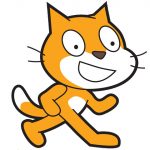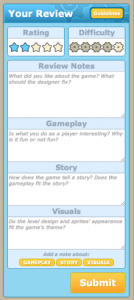 Since my post a couple of weeks ago about Scratch, Meagan Bromley has contributed two really wonderful posts about her work with Gamestar Mechanic and their Online Learning Program where she is currently serving as a mentor/teacher. Between Gamestar Mechanic, Scratch, Meagan’s posts and mine, one very clear throughline that I see emerging is the value being placed on connectivity within the world of creatively driven educational media.
Technology has provided us with a level of connectivity that we have never known before. Yet in terms of young people, with a few exceptions, not enough is being done to teach the affordances and potential consequences of this connectivity. Thankfully, there are wonderful, educationally conscious people who are developing software, online communities, and digital experiences that give kids the chance to hone their ability to interact and connect with others in safe and creatively enriching environments. As Meagan and I have mentioned, both Scratch and Gamestar are two such places where this is happening. Both sites offer kids exciting opportunities to design and create within the context of a group of peers. This community is designed to provide support, feedback, collaboration, and that wonderful feeling of being a part of something bigger than just yourself. Not only that, but both sites have created really nice ways of highlighting the ways in which kids are impacted by and pushed forward by each other.
Since my post a couple of weeks ago about Scratch, Meagan Bromley has contributed two really wonderful posts about her work with Gamestar Mechanic and their Online Learning Program where she is currently serving as a mentor/teacher. Between Gamestar Mechanic, Scratch, Meagan’s posts and mine, one very clear throughline that I see emerging is the value being placed on connectivity within the world of creatively driven educational media.
Technology has provided us with a level of connectivity that we have never known before. Yet in terms of young people, with a few exceptions, not enough is being done to teach the affordances and potential consequences of this connectivity. Thankfully, there are wonderful, educationally conscious people who are developing software, online communities, and digital experiences that give kids the chance to hone their ability to interact and connect with others in safe and creatively enriching environments. As Meagan and I have mentioned, both Scratch and Gamestar are two such places where this is happening. Both sites offer kids exciting opportunities to design and create within the context of a group of peers. This community is designed to provide support, feedback, collaboration, and that wonderful feeling of being a part of something bigger than just yourself. Not only that, but both sites have created really nice ways of highlighting the ways in which kids are impacted by and pushed forward by each other.
Scratch’s remixing capabilities not only give kids the chance to build upon and learn from one another’s work, but the remix tree visualization gives users a really great sense of the connectivity of each other’s work. Gamestar Mechanic’s feedback system is awesome. Users can give overall ratings and difficulty ratings for each others games and are then asked very specific questions to provide a variety of feedback for the different elements of a game.
 Beyond the online interface, both programs are doing a lot to connect with their users and to offer exciting opportunities for them connect with others in novel ways. Gamestar’s recent Online Learning Program utilized professional game designers to provide mentorship, guidance, and feedback through written reviews and video conferencing. They also seem to have some exciting offerings for teachers to help bring the program into classrooms.
Likewise, Scratch is being used in very exciting ways in both formal and informal settings. I’ve spent a number of exciting afternoons working with educators in afterschool programs as kids work together on projects; bouncing ideas off of each other, testing each others code, and utilizing the online community for inspiration and guidance. Whereas I remember my time in computer class being spent with very strict instructions to keep my eyes on my own screen, I walk into these computer classes and I see kids collaborating and working together in teams, helping each other solve problems, and developing super valuable cooperative and collaborative abilities. What I love about this is that technology isn’t just being used to connect people through a screen but it’s also helping to facilitate in person connections. With the importance of those “in person connections” in mind the Scratch Community has worked incredibly hard over the last few years to create Scratch Day; a day in which Scratchers from all over the world get together in their communities to create, play, and learn together. This past year there were over 180 events in 43 countries! At the Media Lab alone, we hosted 400+ Scratchers, and it was truly remarkable to see all the playing and creating that kids, teachers, and parents were engaging in together.
Having safe, challenging, and exciting opportunities in which to connect with others is invaluable for young people today. It’s really exciting to see examples of digital environments and programs that are encouraging and scaffolding the process of what it means to connect with, collaborate with, and learn from others through the use of technology. And just for the record, Scratch and Gamestar are by no means the only two players in this sandbox. There are lots of other people, programs, and resources that are providing great opportunities for young people. Cathy Davidson and Mark Surman just wrote an fantasticpiece for Fast Company and they mention some of the incredible work being done at Mozilla. If you know of other great programs/software/communities for young people that are encouraging similar creativity and connectivity please tell us about them in the comments sections below!
Beyond the online interface, both programs are doing a lot to connect with their users and to offer exciting opportunities for them connect with others in novel ways. Gamestar’s recent Online Learning Program utilized professional game designers to provide mentorship, guidance, and feedback through written reviews and video conferencing. They also seem to have some exciting offerings for teachers to help bring the program into classrooms.
Likewise, Scratch is being used in very exciting ways in both formal and informal settings. I’ve spent a number of exciting afternoons working with educators in afterschool programs as kids work together on projects; bouncing ideas off of each other, testing each others code, and utilizing the online community for inspiration and guidance. Whereas I remember my time in computer class being spent with very strict instructions to keep my eyes on my own screen, I walk into these computer classes and I see kids collaborating and working together in teams, helping each other solve problems, and developing super valuable cooperative and collaborative abilities. What I love about this is that technology isn’t just being used to connect people through a screen but it’s also helping to facilitate in person connections. With the importance of those “in person connections” in mind the Scratch Community has worked incredibly hard over the last few years to create Scratch Day; a day in which Scratchers from all over the world get together in their communities to create, play, and learn together. This past year there were over 180 events in 43 countries! At the Media Lab alone, we hosted 400+ Scratchers, and it was truly remarkable to see all the playing and creating that kids, teachers, and parents were engaging in together.
Having safe, challenging, and exciting opportunities in which to connect with others is invaluable for young people today. It’s really exciting to see examples of digital environments and programs that are encouraging and scaffolding the process of what it means to connect with, collaborate with, and learn from others through the use of technology. And just for the record, Scratch and Gamestar are by no means the only two players in this sandbox. There are lots of other people, programs, and resources that are providing great opportunities for young people. Cathy Davidson and Mark Surman just wrote an fantasticpiece for Fast Company and they mention some of the incredible work being done at Mozilla. If you know of other great programs/software/communities for young people that are encouraging similar creativity and connectivity please tell us about them in the comments sections below!
 Aaron is a recent graduate of the Harvard Graduate School of Education’s Technology, Innovation, and Education. While there he spent his time focusing on how media and technology can be used to foster creativity and connectivity among children. As part of that focus, he had wonderful opportunities to work as an intern for the Joan Ganz Cooney Center and Scratch at the MIT Media Lab. He is also just embarking on a new position as the Assistant Director of Content for PBSKids Interactive.
Aaron is a recent graduate of the Harvard Graduate School of Education’s Technology, Innovation, and Education. While there he spent his time focusing on how media and technology can be used to foster creativity and connectivity among children. As part of that focus, he had wonderful opportunities to work as an intern for the Joan Ganz Cooney Center and Scratch at the MIT Media Lab. He is also just embarking on a new position as the Assistant Director of Content for PBSKids Interactive.